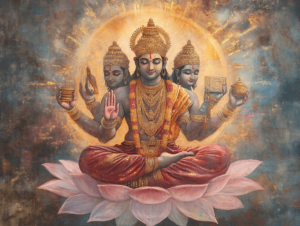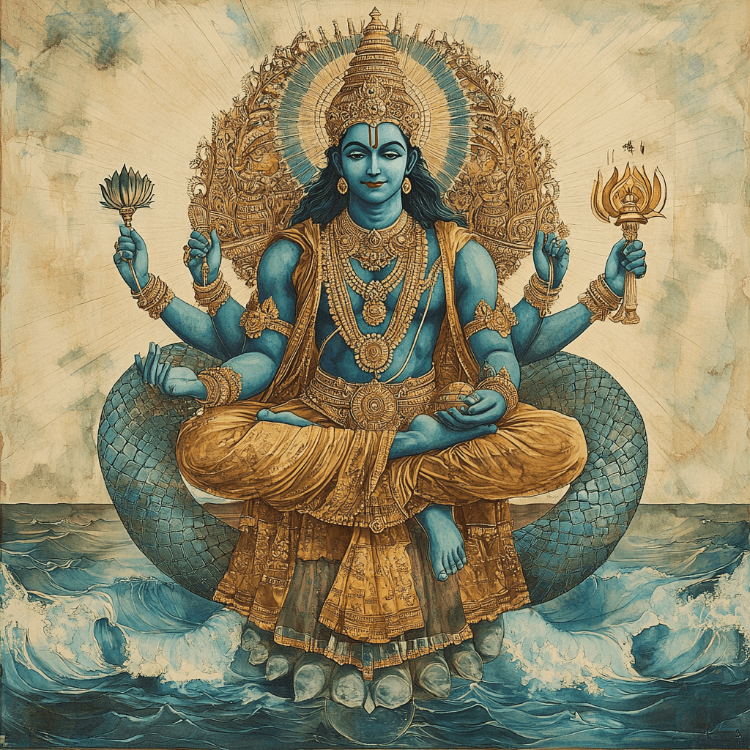
Hinduism is often misunderstood as a polytheistic religion, yet at its core, it recognizes a singular, all-encompassing reality—Brahman—which transcends form and definition. The Trimurti, or Hindu Trinity, personifies this reality through three fundamental cosmic functions: Brahma the Creator, Vishnu the Preserver, and Shiva the Destroyer.
This divine triad represents the eternal cycle of existence: creation, sustenance, and dissolution—principles observed by ancient sages as the rhythm of the universe itself. Rather than separate deities, Brahma, Vishnu, and Shiva are expressions of the same ultimate truth, each embodying an essential aspect of reality.
In this post, we delve into the origins, symbolism, and spiritual significance of the Trimurti, exploring how these divine forces shape our lives and how they have influenced Hindu traditions throughout history.
To begin, let’s get something straight. Even with the Hindu trinity, Hinduism is not a polytheistic religion. Actually, Hinduism is not a religion at all. The word Hindu is British in origin. As the British arrived in India, they discovered more religious traditions than they knew what to do with. In their ignorance and understandable level of overwhelm they simply labelled everyone that lived to the east of the Indus river, ‘Hindu’.
The term serves a very practical purpose, but it is not a religion in itself. Included under this umbrella term there are dozens, maybe hundreds, maybe even thousands of distinct and unique religious/spiritual traditions.
These traditions can be loosely grouped into several categories according to the deities held as the primary personification of the absolute reality. More on these traditions will come in future posts. But for now it is that reality that we are dealing with.
We can make some generalizations to help understanding. All of these traditions agree that there is a formless, un-objectifiable essence of this reality. Often, perhaps most often, Brahman is the accepted and recognized term referring to that essence, although of course each tradition accepts and uses its own terminology.
In their profound wisdom, these human beings understood that this most fundamental intimate essence is not knowable in the way that we know an object. Thus, reality has no objectifiable qualities.
This is also the case in Islam for example, God, or the essence of reality, is unknowable through our common ways of perception. However, since God is not separate from the cosmos, the actions, movements and expressions of that God are knowable.
Thus, energetic principles, known directly by ancient sages, were unknown to modern science until the 1900’s. These sages then, through experience, identified understood, and personified abstract principles as deities. One example is the Hindu trinity, creation, preservation, destruction.
With that cleared up, let’s take a look more deeply at the Trimurti.
During the Vedic period (17-1500 – 500 BCE) we see elements of nature personified as Devas, which are Gods. An example of thise is Indra, the sun or Agni, fire. Some centuries after the Vedic period, we see the appearance of the Puranas. The Puranas were primarily composed between the 4th and 12th centuries.
It is during this period that we begin to see deities such as Shiva, Vishnu and Brahma rise to popularity. It is also during the earlier parts of this period that we begin to see more abstract principles personified as deities, rather than just elements of nature as in the Vedic period.
We have established that we cannot know the absolute objectively. Yet, mystics observed abstract, somewhat mysterious principles unfolding in the world around them. It became clear to them that these mysterious functions were not random and they saw them as expressions of Brahman or the essence.
This was the beginning of the development of the concept of the Trimurti, the Hindu trinity. Brahma represents the spark or impulse that leads to the act of creation/manifestation, Vishnu represents the interest or momentum that sustains the lifespan of any event and Shiva is the expression of the tendency of all phenomena to dissolve back into the formless essence from which they arise.

According to a legend, Brahma was born out of a golden egg that emerged from the naval of Vishnu during a cosmic sleep.
Brahma is by far the least popular of the Hindu trinity. There are various reasons for this. One suggests that since through the act of creating the universe he has already set into motion everything that will happen in this cosmic cycle, therefore he has very little to do. Although this is questionable since at the level of our lived experience, many aspects of our lives are still coming into being.
As the creator of all of the universe Brahma played a vital role in this existence. He is, among other things, the deity of wisdom. In this role he creates 7 sons (Saptarishi), or Maharishis, ‘great sages’, at the start of each cosmic cycle. These Saptarishi guide the unfolding of the universe for the duration of their cosmic cycle. They are the great teachers of humanity that unfold the spiritual wisdom that supports our evolution.
Brahma is depicted as having four heads each sporting a crown, with each head facing one of the cardinal directions. Brahma has eight arms, in each he carries a sacred object: 1) the four Vedas, 2) a rosary, 3) a pot with holy water, 4) a sceptre, 5) a spoon, 6) a disc, 7) a fly whisk, and 8) a lotus flower.
The second member of the Hindu trinity is Lord Vishnu, the preserver. Lord Vishnu finds his earliest mentions as a dwarf in the Vedas. He was a kind of fool or jester to the other gods who would perform great feats for their entertainment. In one story he jumps across the cosmos in 3 great leaps.
However, with time it seems that Vishnu was melded with other gods, perhaps some solar deities. Taking new shape as the Vishnu we eventually find in the Puranas and as the second of the Gods of the Hindu trinity.
Later ,Vishnu became the central figure of the Vaishnava movement, a movement itself made up of several similar religious sects. Each takes various forms of Vishnu, mostly Krishna or Rama as the central deity and primary personification of the divine. The Hare Krishna movement is associated with the Vaishnava sect.
Vishnu is well known for his many incarnations who appear on earth in times of great disparity to save the world.

Shiva, whose name means the auspicious one, is also known as Mahadeva. He is commonly referred to as the destroyer, for this reason he is often feared and equally misunderstood.
As the third member of the Trimurti, Shiva represents the natural dissolution of form into the formless. This might be scary to some as to the body and mind it means death. However to a yogi, this aspect of Shiva is the promise of freedom, liberation or Moksha.
It is also worth considering that there is truly no such thing as destruction. Everything that dies feeds directly into the birth and creation of another thing. So Shiva is equally the precondition of creation. Thus the entire trinity feeds into each other and cannot really be considered separate from each other.
Like Vishnu, Shiva eventually became the central figure of another major movement. Shaivism, sits under the umbrella of ‘Hinduism’. From the Shaivite perspective, Shiva performs all of the functions of the Hindu trinity and more.

We can say that all three Gods of the Hindu Trimurti are equally relevant and essential aspects of the Divine. Therefore, we can turn towards one or several aspects that we are feeling most in resonance with in order to inspire our growth.
People who are spiritually inclined, willing to explore their inner worlds through meditation and tantra, turned away from the lures of the worldly life, drawn to secluded places and loneliness, willing to undergo hardships, uncertainty and social disapproval through self discipline and austerities should follow the path of Lord Shiva.
Students, scholars in the pursuit of knowledge, artists and craftsmen should worship Brahma and Saraswati for inspiration and creativity.
Householders who want to continue their household duties and remain amidst the humdrum of life, should worship Vishnu.
published: 06/06/2020